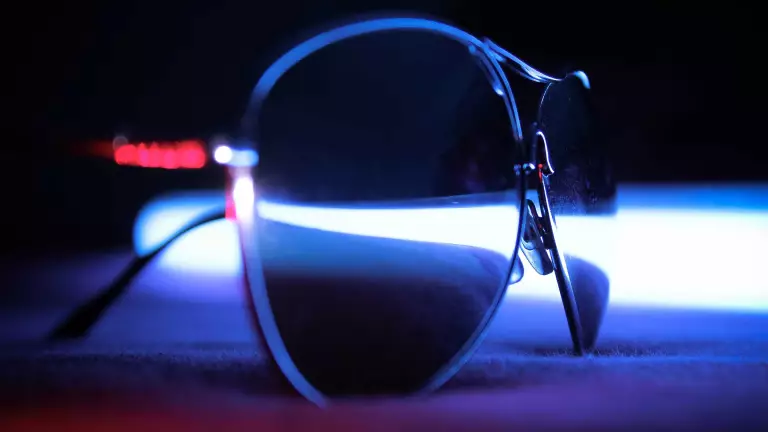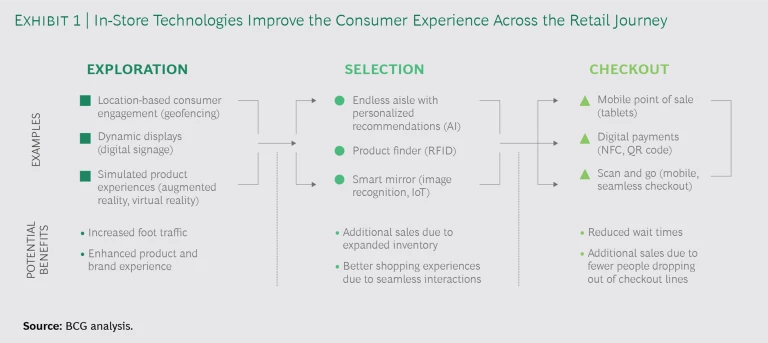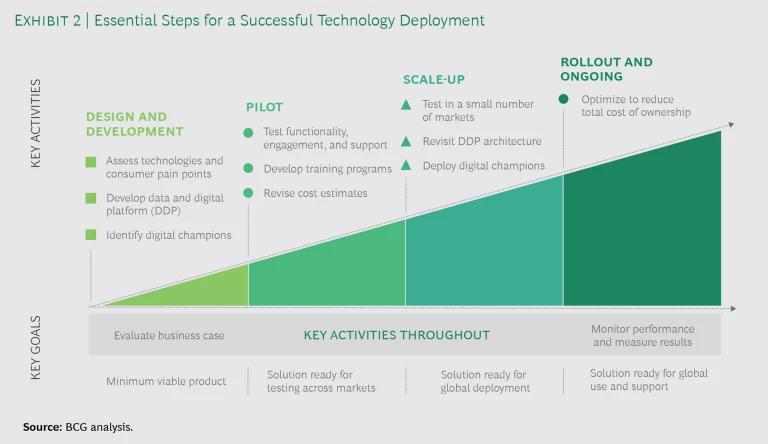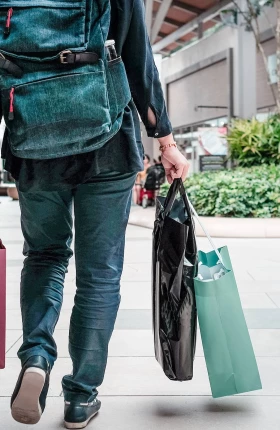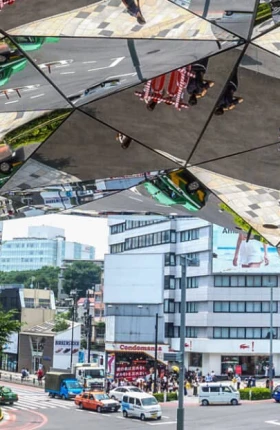As consumers increasingly make their purchases on the internet and physical stores shutter in record numbers, retailers desperate to increase foot traffic are fighting back. They are building stores of the future, a new format that provides consumers with a shopping experience they can’t get online. Deployed at scale, stores of the future have the potential to boost revenue significantly—in our experience, by 5% to 15% per store in just a few months.
Yet efforts to scale are stalling, largely because of issues around the consumer-facing technologies integral to making stores of the future function smoothly. No winning technology has emerged yet, so retailers are forced to develop their own solutions. Frequently they end up with a flagship store decked out with the latest and greatest technologies but little more to show for their huge investment.
To scale stores of the future expeditiously and effectively, retailers often need to add a scale-up phase to the implementation process. This ensures the flexibility needed to make improvements after the pilot and, if necessary, pivot before rolling out an expensive solution to thousands of stores.
Using Technology to Revitalize Physical Stores
While numerous retailers have closed or shrunk their physical stores, and others have declared bankruptcy, some brick-and-mortar retailers are taking the opportunity to recast the role of the physical store in their omnichannel strategies. With a mix of online and offline features, these stores showcase reconfigured formats, cutting-edge technology, and speedy and convenient checkouts. The aim is to turn what was primarily a purchasing transaction into an enjoyable experience that boosts foot traffic and the brand while also enhancing retail productivity.
Companies are using digital technologies to improve three parts of the in-store retail journey: exploration, selection, and checkout. (See Exhibit 1.)
- Exploration. Digital signage with touchscreens is making it easier and more enjoyable for consumers to navigate stores. Augmented and virtual reality technologies enable people to interact with products, enhancing the overall brand experience. A sporting goods store in Shanghai, for example, has a video game where consumers can lace up a pair of sneakers and play a game of basketball interactively via WeChat. Flagship stores in particular tend to use these kinds of technologies.
- Selection. New technologies are also helping expand the number of products available and make product selection more seamless and personalized. The goal is to enable consumers to easily navigate a vast assortment of products and select the ones that suit them best. This experience can start online, before consumers even enter the store. Some retailers are also experimenting with “endless aisle” technologies, such as kiosks that allow consumers to browse or order items that are currently out of stock. Apparel retailers are using visual AI to recommend new outfits on the basis of what consumers are wearing. And grocery chains are using smart labels to provide product information, such as detailed descriptions of ingredients and allergens, that can’t fit on a label; shoppers just have to scan the label with their smartphones.
- Checkout. In addition, companies are using digital to make the checkout experience as hassle-free as possible. Digital wallets make purchasing activity seamless, and several retailers have done away with fixed registers and checkout lines altogether. Some companies use sensors and computer vision for a cashier-free experience; others provide scan-and-go checkout capabilities in a smartphone app. A European retailer’s new app allows consumers to point their phones at groceries and then pay for their items at checkout in just 20 seconds. The company’s goal is checkouts that don’t even require a device.
From Design to Rollout
While digital technologies have the potential to significantly improve foot traffic and revenue, few retailers have rolled them out at scale. Our experience with clients across subsectors worldwide suggests that focusing on specific activities during the four phases of deployment—design and development, pilot, scale-up, and rollout—can help retailers implement these technologies quickly and effectively. (See Exhibit 2.)
Design and Development
The goal in this phase should be to develop a minimum viable product that addresses consumer pain points. But retailers have often invested heavily in a technology without first determining its benefits or the cost of deploying it at scale. In the rush to get something out there, they may not think through the cost of making it work in thousands of stores.
Moreover, given the lack of a universally superior technology, retailers are forced to use multiple technologies in different variations across their stores, updating them frequently in the quest to keep consumers interested. Matters are often further complicated by the existence of multiple backend systems resulting from mergers, joint ventures, or franchise relationships. As a result, companies have to build different technology stacks for different retail innovations, which requires integrating each stack with existing platforms.
Some retailers understand that it’s better to start by investing in a technology foundation. But often these are built by niche IT teams, which may underestimate the effort required to clean data or integrate the new technology with retail legacy systems.
To address these challenges, four tasks are critical.
- Assess the technology portfolio. First, the product team needs to assess the various technologies the company is already using in stores to determine if they sufficiently address current consumer pain points. If not, are there newer ones on the market that can fill the gap?
- Evaluate the business case. Given the immense cost and time required to scale and roll out a technology, retailers must be certain that the one they select delivers the best ROI. Companies need to estimate the impact the new solutions will have on in-store sales while also determining the size of the technology investment and the cost of training and ongoing support. Retailers should evaluate the business case upfront during the design and development phase and then execute it during the remaining phases of the implementation.
- Start building a flexible and scalable data and digital platform (DDP). A scalable and flexible platform makes it possible to roll out future solutions faster and more easily. The platform should have reusable components such as microservices and built-in application program interfaces (APIs) that connect to different legacy platforms. After the first rollout, retailers can leverage the same microservices to build many different in-store digital solutions instead of creating a unique tech stack for each one. The DDP, which is best built incrementally throughout implementation, should be flexible enough to adapt to consumer expectations and to specific technology differences and legislation in different locations. Its infrastructure needs to be harmonized so it can connect well globally, but also sufficiently modular to accommodate in-store hardware equipment. The infrastructure should also allow new or upgraded applications to be used while leveraging existing in-store technology such as screens or sensors as much as possible. Retailers can approach technology investments in different ways, depending on their organization structure and culture. For example, a US fast-food chain that had the same organizational structure and culture around the world standardized its systems and infrastructure so it could roll out the same technology everywhere. By contrast, a global sporting goods dealer that preferred developing innovations from the ground up gave its stores the freedom to define standards specific to their particular city or region. This approach required investments in foundational and reusable APIs that were open and accessible to the organization at each specific location. The setup allowed each city to develop its own digital experiences while reusing elements from experiences that worked well in other cities.
- Enlist the aid of digital champions. The retail operations team needs to appoint retail associates in the stores to serve as digital champions who will drive adoption and serve as key points of communication back to retail technology team.
Pilot
Most retailers implement in-store technologies from established tech companies. Since these technologies are already built for scale, there is little need for scale-up, other than building interfaces and small customizations to prevent performance or cost issues.
Focusing on specific activities during the four phases of deployment can help retailers implement digital technologies quickly and effectively.
Retailers that wish to use newer technologies must either build the solutions themselves or work with smaller tech players that dominate in this space. But smaller companies usually don’t have employee manuals or other aids. Consequently, many retailers build a pilot to test usability at a single store and then go straight to a major rollout without taking steps to ensure that it’s reliable, scalable, or user-friendly in different markets.
The results are somewhat predictable: the solution breaks down, can’t be integrated with the existing system, or is too expensive. Worse yet, it may simply sit idle because retail associates don’t understand how to operate it. With new technologies that are designed to be used by consumers, retailers need to focus on usability and product design, not just functional capabilities.
Scale-Up
To solve many of the issues that plague pilots, we recommend adding a whole new step to the deployment: scale-up. This is the time to review and improve both the overall solution and the individual microservices. It’s important to determine not just whether the technology works, as when launching a pilot, but also whether it’s inexpensive and reliable enough to be used by a full network of stores. Other questions to ask: Can expensive components be swapped out for cheaper ones? Is data usage too high? Can the technology be used in stores with space constraints? This is also the time to develop training and knowledge transfer programs. Four practices are critical:
- Start small. Introduce the new technologies in a small representative sample of the company’s stores, such as urban and suburban outlets in different geographical regions, and test end to end. This is no easy task. It requires determining which stores serve which particular consumer segments and whether those stores are a good fit for testing a particular technology.
- Expand the DDP. If the technology comes up short, the tech team needs to take a step back and reengineer it. This can mean improving the code quality of current microservices or leveraging more-mature (commercial) microservices. More-advanced cloud solutions for data storage and processing should also be considered. To accommodate higher volumes of users and greater needs for stability, it may even be necessary to refactor components or, in the worst-case scenario, rewrite code from scratch.
- Provide strong tech support to allow exponential rollout. During scale-up, the tech support team needs to develop standard operating procedures and training materials. The team also needs to come up with a way to update these materials throughout the implementation and, equally important, to share them across stores and regional teams. This all has to be done quickly—the speed of the rollout depends upon it.
- Put the digital champions to work. This is also the time for the digital champions to get started—both regional champions, who travel to stores to test the technology, and local champions, who help consumers who are having problems using the technology in the stores. To facilitate a speedy rollout, leading retailers use the train-the-trainer process, where the global organization trains the regional champions. They, in turn, train the local champions, who train the store associates.
With new technologies that are designed to be used by consumers, retailers need to focus on usability and product design.
Rollout
During the rollout phase, retailers must optimize performance and maximize ROI as quickly as possible. This make it critical to monitor reliability, scalability, and cost in order to spot opportunities for improvement. This means examining and tweaking the components that make up the technology foundation. Say, for example, that stores in North America have interactive video, which requires more bandwidth. If in the course of the scale-up it becomes clear through testing that all stores outside of North America should have this video capability as well, the additional bandwidth requirement could become a global standard.
Staying on Course for Success
In our experience, a few practices need to be followed throughout all four phases:
- Reevaluate the business case. The portfolio is likely to change continually as a result of technological evolution, and the ways in which consumers will use technologies are likely to change as well. So it’s important to update the business case on a regular basis to make sure ROI is still being maximized. This means evaluating different elements of the business case during different stages. Retailers should focus on functionality in the pilot stage, value at initial rollout, and speed of change during scale-up. All different impacts should be measured, including changes in foot traffic, the number of people dropping out of checkout lines, and purchases made online after a store visit. It’s also important to evaluate the overall brand experience, reflected, for example, in whether consumers interact with the product in the store.
- Collaborate across functions. It’s crucial to start working cross-functionally early on. People from product, retail operations, tech solutions, and tech support should be involved early enough to understand what is being developed and how it fits into the overall store strategy. Representatives from both the central and local teams need to be included.
- Set up—and use—feedback loops. Sometimes the deployment process is not linear and solutions have to be redesigned or refactored. So it’s vital to incorporate a feedback loop between retail stores and the product team to continuously learn how the product can be improved. Tech teams also need to get comfortable with the need to make constant technical improvements, rather than simply developing new features.
- Motivate store associates. Retailers need to create incentives for store associates to embrace the new solution, including both commissions on sales made with in-store technologies and nonfinancial rewards that make employees feel valued. In our experience, the best performing stores of the future are those where associates engage actively with the technology.
Store-of-the-future technologies hold great promise for retailers that know how to scale them quickly. This is especially true for companies with a relatively large proportion of internet sales, such as clothing retailers. Since more clothing is purchased online than, for example, food, deploying in-store technologies is more urgent for apparel companies than for grocers. Providing consumers with the extra level of service that they can’t get online is essential for getting them into stores.
Regardless of category, all retailers need to start building in-store digital capabilities today. Before long, the technology used in the store of the future will be critical to engaging consumers and building sustainable success.
